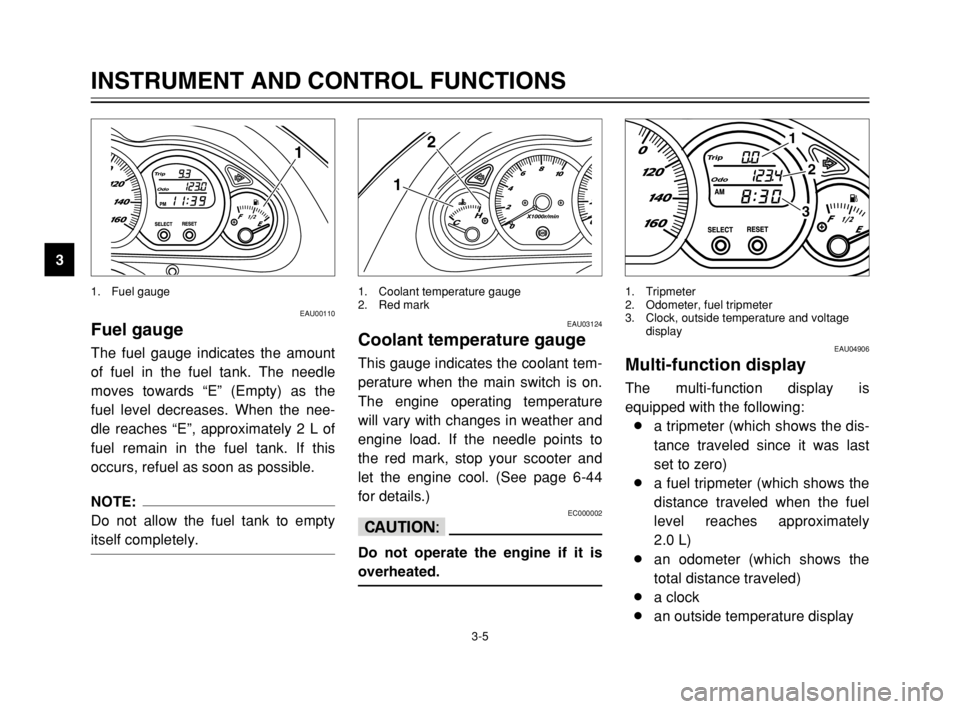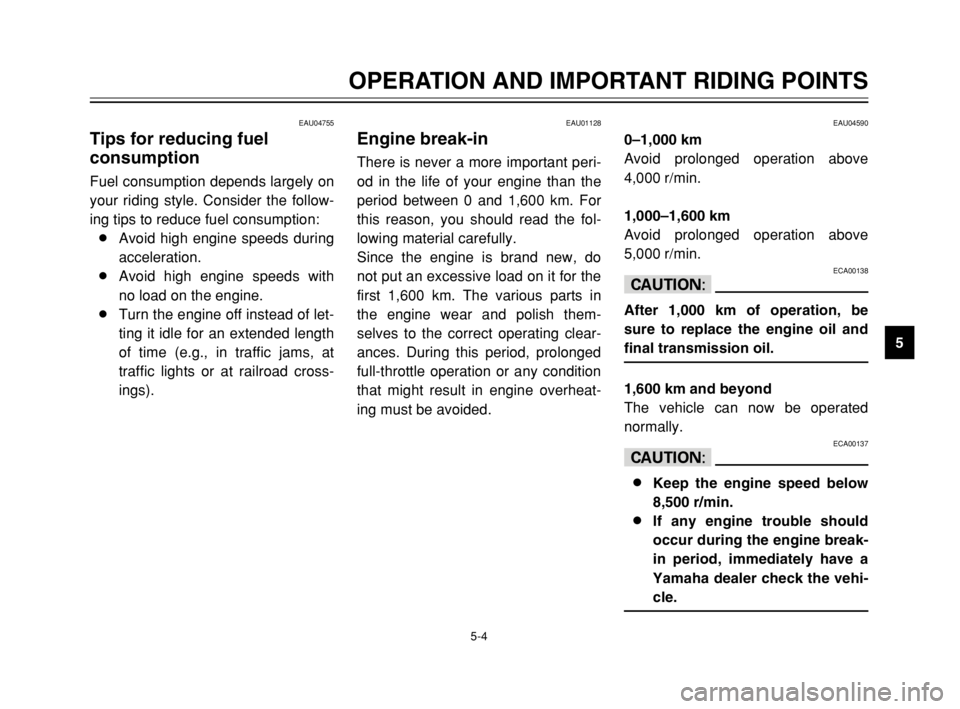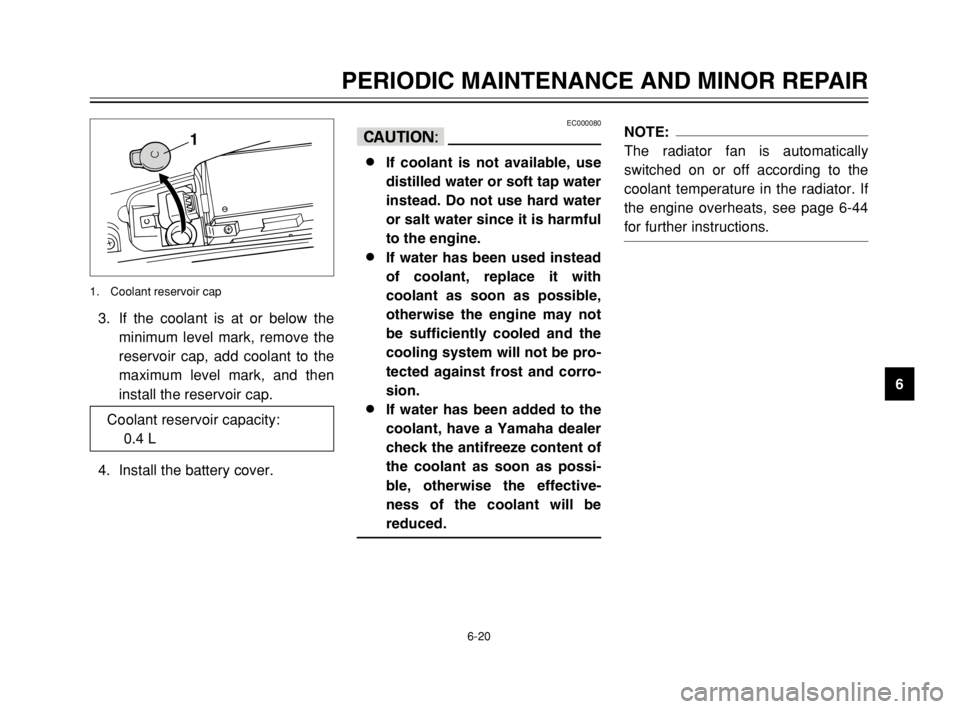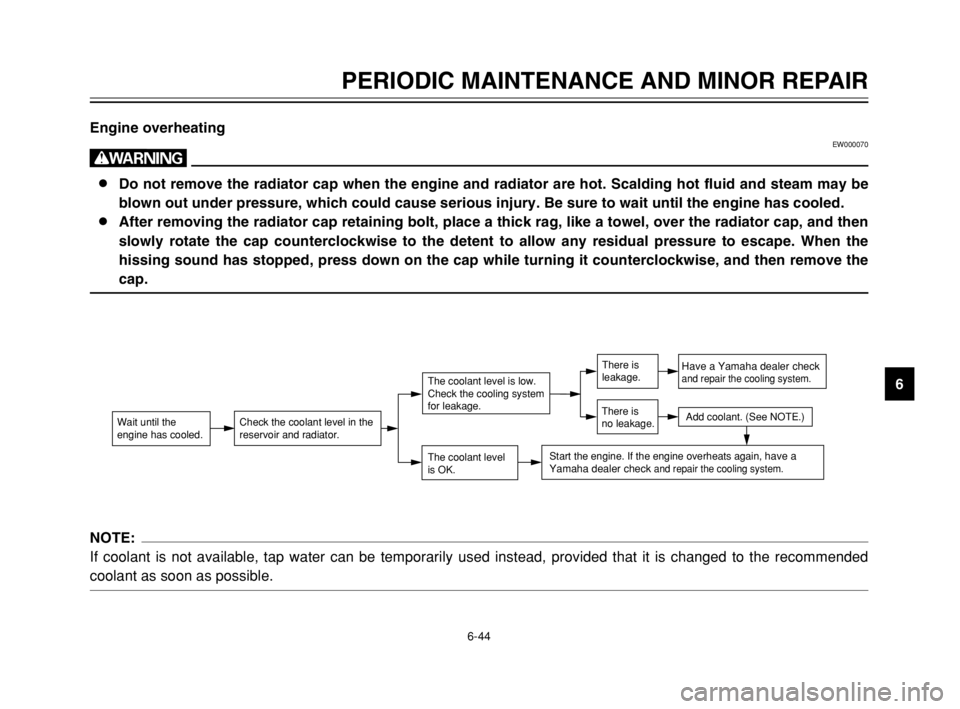Page 22 of 116

EAU00110
Fuel gaugeFuel gaugeThe fuel gauge indicates the amount
of fuel in the fuel tank. The needle
moves towards “E” (Empty) as the
fuel level decreases. When the nee-
dle reaches “E”, approximately 2 L of
fuel remain in the fuel tank. If this
occurs, refuel as soon as possible.
NOTE:
Do not allow the fuel tank to empty
itself completely.
INSTRUMENT AND CONTROL FUNCTIONS
3
1
1. Fuel gauge
EAU03124
Coolant temperature gaugeCoolant temperature gaugeThis gauge indicates the coolant tem-
perature when the main switch is on.
The engine operating temperature
will vary with changes in weather and
engine load. If the needle points to
the red mark, stop your scooter and
let the engine cool. (See page 6-44
for details.)
EC000002
cC
Do not operate the engine if it is
overheated.
1
2
1. Coolant temperature gauge
2. Red mark
EAU04906
Multi-function displayDisplay, multi-functionThe multi-function display is
equipped with the following:
8a tripmeter (which shows the dis-
tance traveled since it was last
set to zero)
8a fuel tripmeter (which shows the
distance traveled when the fuel
level reaches approximately
2.0 L)
8an odometer (which shows the
total distance traveled)
8a clock
8an outside temperature display
1
2
3
1. Tripmeter
2. Odometer, fuel tripmeter
3. Clock, outside temperature and voltage
display
3-5
5SJ-28199-E1 7/11/02 11:03 AM Page 20
Page 49 of 116

5-4
OPERATION AND IMPORTANT RIDING POINTS
5
EAU04755
Tips for reducing fuel
consumption
Fuel consumption, tips for reducingFuel consumption depends largely on
your riding style. Consider the follow-
ing tips to reduce fuel consumption:
8Avoid high engine speeds during
acceleration.
8Avoid high engine speeds with
no load on the engine.
8Turn the engine off instead of let-
ting it idle for an extended length
of time (e.g., in traffic jams, at
traffic lights or at railroad cross-
ings).
EAU01128
Engine break-inEngine break-inThere is never a more important peri-
od in the life of your engine than the
period between 0 and 1,600 km. For
this reason, you should read the fol-
lowing material carefully.
Since the engine is brand new, do
not put an excessive load on it for the
first 1,600 km. The various parts in
the engine wear and polish them-
selves to the correct operating clear-
ances. During this period, prolonged
full-throttle operation or any condition
that might result in engine overheat-
ing must be avoided.
EAU04590
0–1,000 km
Avoid prolonged operation above
4,000 r/min.
1,000–1,600 km
Avoid prolonged operation above
5,000 r/min.
ECA00138
cC
After 1,000 km of operation, be
sure to replace the engine oil and
final transmission oil.
1,600 km and beyond
The vehicle can now be operated
normally.
ECA00137
cC
8
8
Keep the engine speed below
8,500 r/min.
8 8
If any engine trouble should
occur during the engine break-
in period, immediately have a
Yamaha dealer check the vehi-
cle.
5SJ-28199-E1 7/11/02 11:03 AM Page 47
Page 71 of 116

6-20
PERIODIC MAINTENANCE AND MINOR REPAIR
6 3. If the coolant is at or below the
minimum level mark, remove the
reservoir cap, add coolant to the
maximum level mark, and then
install the reservoir cap.
4. Install the battery cover.
1
1. Coolant reservoir cap
NOTE:
The radiator fan is automatically
switched on or off according to the
coolant temperature in the radiator. If
the engine overheats, see page 6-44
for further instructions.EC000080
cC
8
8
If coolant is not available, use
distilled water or soft tap water
instead. Do not use hard water
or salt water since it is harmful
to the engine.
8 8
If water has been used instead
of coolant, replace it with
coolant as soon as possible,
otherwise the engine may not
be sufficiently cooled and the
cooling system will not be pro-
tected against frost and corro-
sion.
8 8
If water has been added to the
coolant, have a Yamaha dealer
check the antifreeze content of
the coolant as soon as possi-
ble, otherwise the effective-
ness of the coolant will be
reduced.
Coolant reservoir capacity:
0.4 L
5SJ-28199-E1 7/11/02 11:03 AM Page 69
Page 95 of 116

6-44
PERIODIC MAINTENANCE AND MINOR REPAIR
6 Engine overheating
EW000070
w
8 8
Do not remove the radiator cap when the engine and radiator are hot. Scalding hot fluid and steam may be
blown out under pressure, which could cause serious injury. Be sure to wait until the engine has cooled.
8 8
After removing the radiator cap retaining bolt, place a thick rag, like a towel, over the radiator cap, and then
slowly rotate the cap counterclockwise to the detent to allow any residual pressure to escape. When the
hissing sound has stopped, press down on the cap while turning it counterclockwise, and then remove the
cap.
NOTE:
If coolant is not available, tap water can be temporarily used instead, provided that it is changed to the recommended
coolant as soon as possible.
Wait until the
engine has cooled.Check the coolant level in the
reservoir and radiator.
The coolant level
is OK.
The coolant level is low.
Check the cooling system
for leakage.
Have a Yamaha dealer checkand repair the cooling system.
Add coolant. (See NOTE.)
Start the engine. If the engine overheats again, have a
Yamaha dealer check and repair the cooling system.
There is
leakage.
There is
no leakage.
5SJ-28199-E1 7/11/02 11:03 AM Page 93